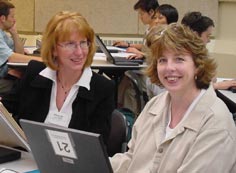
|
 |
Text Analysis: Example 3
Example of a Completed Written
Text analysis
Tara Fortune & Diane Tedick
Theme: Change can happen in “cycles”
Title: Carle, E.
(1994). La oruga muy hambrienta. NY: Philomel Books. (Book available
from Amazon.com)
Grade Level: 1st-2nd grade
Language Proficiency Level: Novice-high (lit); Intermediate-low
(oral)
Content
Key related concepts
Growth and change; life cycles; stages; living organisms; metamorphosis |
Facts
A little egg sleeps on a leaf at night. One Sunday morning a small,
very hungry caterpillar set out. It immediately began to look for
food. Each day it ate something but remained very hungry. After eating
all week long, it got a bad stomachache. A week later it ate a beautiful
leaf and felt much better. Now it was no longer a small hungry caterpillar,
but a big, fat caterpillar. It built itself a little house and went
inside the cocoon for two weeks. Then one day it poked a hole in
the cocoon and began to come out. It discovered that it had become
a very, very beautiful butterfly! |
Essential Understandings or “Big” Ideas
(Generalizations)
Change is a part of life. All living organisms change. Change can
happen in “cycles.” Living organisms can grow in different
ways. Growing organisms have certain needs. |
Culture
Unfamiliar Cultural Assumptions
Products (unfamiliar or familiar but
used in a new way)
|
Practices (unfamiliar or familiar but used
in a new way)
Eating a leaf to settle one’s stomach.
|
Perspectives
Cures for what ails you are best found in nature.
|
Genre
Text Organization
Purpose (e.g., present information, teach
a moral, entertain, etc.)
To entertain (narrative that combines real events about the life
cycle with imaginary events to entertain), teach a lesson about
life cycle of butterfly (similar to explanatory text)
|
Text Structure (e.g., introduce setting/character,
events, problem/resolution, etc.)
Explanation told as narrative:
Phenomenon: life cycle of the butterfly;
Setting: Nature—on the leaf, on the ground, in the cocoon;
Series of events: Caterpillar comes out of the egg, eats everything
in sight, gets a stomach ache, eats a green leaf to settle stomach,
constructs a cocoon, in two weeks emerges as butterfly.
|
Linguistic Features related to Genre [connectives,
(e.g., adverbs of time, conjunctions), verb type (action vs. saying
verbs), verb tense, use of dialogue, etc.]
Connectives (adverbs of time): al día siguiente, ahora,
el lunes, en seguida, un domingo de mañana, etc.;
Verb types/tenses (action verbs in past tense): comió, construyó,
se quedó, se sintió, salió, se encerró,
Relational or linking verbs: era, tenía, seguía,
etc.;
Describing words: grande, gorda, bellísima,
hermosa, convertida, hambrienta, etc.
|
Learning Strategies and Possible Instructional Activities
Before Reading
Picture walk through the story; predict title/story/characters
based on review of cover, Activate schemata (prior knowledge)
on the growth of butterflies and make personal connection to
needing food to grow and feeling sick from eating too much. Linking
new vocabulary on food items with words/picture cards. Tell a
partner about one time when you recall feeling very hungry and
one time when you recall feeling very full.
|
During Reading
Use picture cues to assist with story comprehension; Classify/Use
a graphic organizer—Make a T-chart and list the days of
the week under one column and the things that the caterpillar
eats on the other; Make a list of verb phrases describing what
the caterpillar does at each stage, and then draw how the caterpillar
looks during each of these stages.
|
After Reading
Summarize—Carry out a story retelling using past tense
verbs and focus on accurately sequencing the activities using
adverbs of time e.g., El domingo salió y empezó a
buscar comida. Using the “pero aún seguía
hambrienta” pattern, construct a short story about someone
who just couldn’t eat enough to stay full.
Personalize—Draw
a picture of a time when you were amazed because you could see
that you had grown up and were no longer a baby and write a sentence
describing how you looked and felt about being a child and not
a baby.
|
Language
Vocabulary (Words, Phrases, Idioms)
Essential vocabulary for learning the content
(CO)
La hoja, el huevecillo, la oruga, el capullo, la mariposa
Key verbs: salir, comer, construir
Key reflexive verbs: quedarse, sentirse, encerrarse, encontrarse
Key adverbs of time: al día siguiente, ahora, el lunes,
en seguida, un domingo de mañana, etc
|
Select vocabulary to review or preview (material
or activity related) (CC)
Days of the week, numbers (1-10), and healthy/unhealthy foods
Chunks: pero aún seguía hambrienta, tuvo un tremendo
dolor de estómago
Expression with tener: tener o no tener hambre
Adjectives: grande, gorda, bellísima, hermosa, convertida,
hambrienta, etc.
|
Grammatical Structures and Communicative Functions
Essential language structures and functions
for learning the content (CO)
Key verbs in 3rd person singular preterite to describe past events
Use adverbs of time to sequence a series of events
Key nouns to identify the four stages of a butterfly’s life
cycle
|
Select language structures and functions to
review or preview (material or activity related) (CC)
Use of suffixes: –ita/o, –illa/o to indicate small
Use of imperfect to describe past continuous action or provide
background context
Adjective-noun agreement and placement including typical and atypical
placement of adjectives
|
|
|

